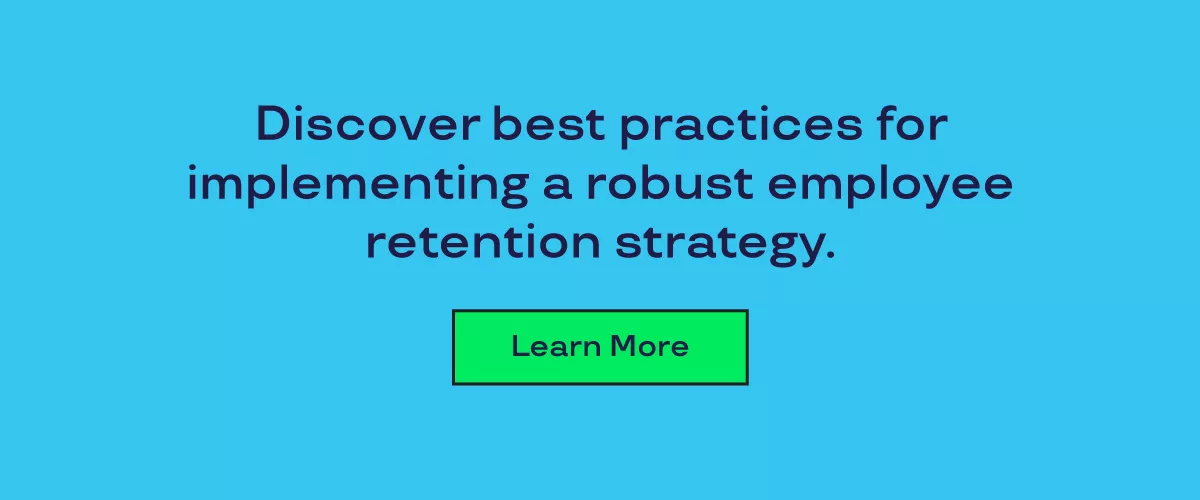
The Most Effective Employee Retention Strategies for Long-Term Success
December 21, 2023
With the expanding pool of remote job opportunities, organizations are facing an even greater challenge with retaining their top talent. The competition for attracting and retaining skilled professionals is fierce despite the job market cooling off in 2023, requiring organizations to adopt intentional strategies for talent retention.
But why is turnover such a pressing concern? High employee turnover can be both costly and disruptive for companies. The expenses related to hiring and training replacements can quickly add up, with studies showing that organizations may spend up to six to nine months’ worth of an employee's salary to find and onboard a suitable replacement.
In this blog post, we explore the leading reasons employees voluntarily leave an organization and seven effective retention strategies you can use to retain your valuable workforce.
Why do Employees Leave?
Employee turnover continues to remain an issue for many organizations. In fact, Gallup’s 2023 State of the Global Workforce report found that 51% of employees are actively seeking another position.
If you are experiencing a higher-than-average turnover rate, it’s important to understand the most common drivers of high turnover. Here are some of the leading reasons why employees leave:
-
Lack of Career Growth: Many employees seek opportunities for career advancement and professional development. They want to feel challenged and fulfilled by their roles. When they feel stagnant and see no clear path for growth within the organization, they are more likely to explore other options.
-
Poor Work-Life Balance: A healthy work-life balance is crucial for employee well-being. In fact, work flexibility and work-life balance is highly valued by today’s workforce. Long hours, excessive workload, and a lack of flexibility can lead to burnout and ultimately push employees to look for jobs with better work-life balance.
-
Inadequate Compensation: Competitive compensation packages are essential for attracting and retaining top talent. Employees feel that they are not adequately compensated for their skills and contributions may be tempted to leave for higher-paying positions elsewhere. Research backs this up, indicating that fair compensation is a top driver of employee satisfaction across most of the workforce.
-
Lack of Recognition: Employees want to feel valued and appreciated for their hard work. When organizations fail to recognize and reward employees for their achievements, it can lead to a decline in morale and loyalty. Employees who are recognized are almost six times more likely to stay at their jobs than those who aren’t, as reported by Zippia.
-
Poor Management and Leadership: Supervisors and managers play a significant role in employee satisfaction. A toxic work environment, conflicts with colleagues, or ineffective leadership can drive employees away. Not only can it lead to high turnover, but it can result in decreased productivity and lack of innovation.
What are the Best Employee Retention Strategies?
Now that we understand why employees leave, let's explore some of the most effective employee retention strategies organizations can adopt to keep their workforce engaged and motivated.
Employee retention strategies are essential for propelling an organization forward. A high turnover rate can cause significant disruption within an organization, hindering its growth, innovation, and profitability.
While some turnover is unavoidable, there are several employee retention strategies you can put into place to proactively prevent turnover. Here are a few that stand out:
1. Career Development Opportunities
Studies show that organizations with a strong learning culture have 30%-50% higher engagement and retention rates. To help retain top talent, provide your employees with a clear path for career advancement and professional growth opportunities. A great way to do this is by implementing mentorship programs, training, and development initiatives to help employees acquire new skills and progress in their careers.
2. Competitive Compensation and Benefits
Robert Half revealed that competitive compensation is highly influential on job satisfaction. Offer your staff competitive salaries, bonuses, yearly raises, and comprehensive benefits packages to help retain them. Additionally, conduct annual compensation reviews to ensure they align with industry benchmarks.
3. Work-Life Balance
A cost-effective way you can retain employees is through encouraging work-life balance. Since the pandemic, work-life balance has become a highly sought-after benefit by employees. In fact, a survey by Muse found that 83% of employees would take a lower paying job if it had a better work-life balance.
Promote a healthy work-life balance within your organization by encouraging flexible work arrangements, providing remote work options, and discouraging excessive overtime. Ensure employees have time to recharge and spend with their families to limit burnout and improve satisfaction.
4. Employee Recognition and Appreciation
Employees in every organization want to feel seen and valued for their hard work and contributions. When employees are recognized and appreciated, the likelihood of them staying at a company longer increases drastically. In fact, Zippia reports that recognized employees are almost six times more likely to stay at their jobs than those who aren’t.
Consider implementing non-monetary or monetary-based employee recognition programs, celebrating big achievements, and honoring service anniversaries to foster a culture of appreciation that helps retain your employees.
5. Leadership and Management Training
Research shows that leadership and management have a significant impact on employee turnover and company culture. To set your teams up for success, invest in leadership development programs that equip managers and supervisors with the skills necessary for effective leadership. Additionally, encourage management to lead with open communication and transparency with their direct reports to foster a culture of trust.
6. Employee Sentiment Analysis
One of the best strategies to reduce excessive turnover is soliciting honest feedback. Implement company-wide surveys to get actionable insight into how employees feel about your organization.
Tip: Providing your staff with an anonymous pulse survey is the best way to gain real-time insight into employee sentiment. With these surveys in place, you can tailor your employee retention initiatives on the fly and resolve underlying issues within the company.
7. Regular Feedback and Performance Reviews
As we all know, constructive feedback is necessary for employee growth. If your employees aren't challenged and aren't advancing their skills, chances are they will start looking for a job elsewhere. To mitigate this, conduct regular performance reviews and encourage managers to provide constructive feedback with their teams. Help employees set realistic goals and provide them with the tools and resources they need to succeed.
Employee retention is a critical aspect of any organization’s success. By understanding why employees leave and implementing employee retention strategies, companies can reduce turnover, improve morale, and ultimately, achieve better business outcomes.





